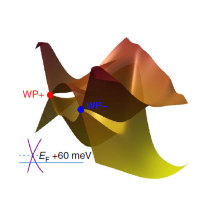Topological Materials
Topological materials harbor chirality and non-dissipative surfaces or bulk states, which enable them to exhibit exotic physical properties such as anomalous Hall effect, anomalous Nernst effect, and chiral anomaly, etc., which endow them a great potential in fabricating spintronic devices. The topological state is protected by either lattice inversion symmetry or time-reversal symmetry. In the recently discovered ferromagnetic topological materials (such as Co3Sn2S2 [1], Fe3Sn2 [2]), spontaneous magnetization breaks the time-reversal symmetry and affects the topological state. The interaction between topology and magnetism is a burgeoning topic. Even though it is widely investigated, many questions remain unanswered.
Optical spectroscopy is a powerful tool to study the charge dynamics. Since the optical conductivity is proportional to the joint density of state [3], it can indirectly provide us the information of band structure as well as the topological sate. In this project, we are going to systematically investigate the optical properties of magnetic topological material Co3Sn2S2. By measuring its temperature-dependent optical response, we will analyze the interaction between the topology and the magnetism.
Keywords: Optical spectroscopy, magnetic topological material
References
- Liu, E. et al. Giant anomalous Hall effect in a ferromagnetic Kagome-lattice semimetal. Nat Phys 14, 1125-1131 (2018).
- Ye, L. et al. Massive Dirac fermions in a ferromagnetic kagome metal. Nature 555, 638-642, (2018).
- Dressel and G. Grüner, Electrodynamics of Solids (Cambridge University Press, Cambridge, England, 2002).

Run Yang
Dr.Fellow of the Alexander von Humboldt Foundation

Martin Dressel
Prof. Dr. rer. nat.Head of Institute



